As the market leader, Bruker introduces the world’s first commercially available solid-state dynamic nuclear polarization-enhanced NMR system (DNP-NMR)
Bruker’s 263, 395 and 527 GHz DNP-NMR Spectrometers are the world’s first commercially available solid-state dynamic nuclear polarization (DNP-NMR) systems . All DNP-NMR spectrometers enable extended solid-state NMR experiments with unsurpassed sensitivity for exciting new applications in biomolecular research, material science, and pharmaceuticals. The Bruker DNP spectrometers have a proven record of performance over 25 systems installed worldwide.
Signal enhancements from 20 to a factor of 200, driven by microwave irradiation to transfer polarization from unpaired electron spins to nuclear spins. The unique high power gyrotron systems, delivering microwaves at 263 GHz,395 GHz, and 527 GHz are robust, safe and easy-to-use, enabling long term DNP experiments without time limitations.
DNP Boltzmann Polarization
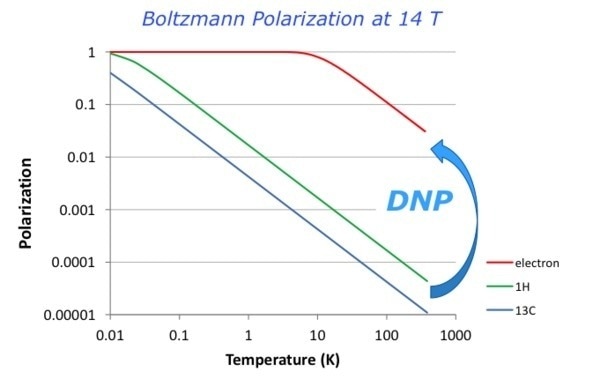
Image Credit: Bruker BioSpin Group
DNP samples are prepared by adding a polarizing agent or exploiting a native radical on the sample of interest. Experiments are performed at a low temperature of ~100 K with continuous microwave irradiations and benefit from the innovative low-temperature MAS probe that enables sample polarization in-situ, directly at the NMR field.
- Turn-key solution for DNP-enhanced solids NMR experiments at high field
- Polarization enhancement yields factor up to 200 gain in sensitivity for solid-state NMR
- Unique high power microwave sources
- Easy-to-use software-controlled high power gyrotron
- Optimum beam propagation to the sample ensured by microwave transmission lines
- Low-temperature MAS probe technology with built-in waveguide and cold spinning gas supply
- AVANCE™ III HD 400, 600 and 800 wide bore NMR system with sweep coils
Moving beyond the horizon of possibility
Development and Commercialization of Dynamic Nuclear Polarization (DNP) with Professor Robert Griffin.
Technical Details
Gyrotron Microwave Source
The gyrotron includes a sealed custom-designed gyrotron tube, superconducting magnet, and control system, all designed to provide high stability, reliability, and ease of operation. Beam propagation to the sample is ensured by high microwave beam quality and corrugated waveguide. The sample is polarized in-situ in a low-temperature NMR MAS probe.
Source: Bruker BioSpin Group
| 1H NMR Frequency |
WB NMR Magnet |
Gyrotron Frequency |
Gyrotron Magnet |
| 400 MHz |
400/89 Ascend DNP |
263 GHz |
4.8 T cryogen-free |
| 600 MHz |
600/89 Ascend DNP |
395 GHz |
7.2 T cryogen-free |
| 800 MHz |
800/89 USP RS |
527 GHz |
9.7 T cryogen-free |
LT MAS Probe
- Low sample temperature (~ 100 K)
- Cold sample coil and RF circuit
- 3.2 mm MAS rotor (17 kHz max at 100 K)
- WB triple resonance probe (H/C/N)
- Insert/eject of cold samples
- Dry low-temperature nitrogen gas supply
- 3 lines: bearing, drive and VT
- Automatic refill of liquid nitrogen supply
- Waveguide for microwave irradiation
- Long term operation (days, weeks)
1.9 mm DNP MAS Probe
DNP experiments are performed at low temperature (100 K) for efficient transfer of polarization from electron spins to nuclear spins. Until recently, the spinning frequency at 100 K was limited to 15 kHz with a 3.2 mm rotor. With the introduction of the Bruker 1.9 mm low-temperature MAS (LTMAS) probe, DNP experiments can now be performed at up to 25 kHz MAS frequency for enhanced spectral resolution. The 1.9 mm probe includes pneumatic insert/eject capability at ambient and cold temperature. The ability to change samples while the probe remains cold is critical for optimal use of experiment time. The probe is available with HCN or HX NMR circuits.
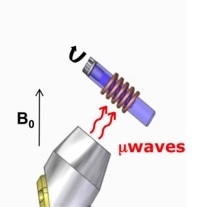
Image Credit: Bruker BioSpin Group
Control Systems
- User Interface
- Controls and regulation
- Temps, voltages, water cooling, gyrotron magnet
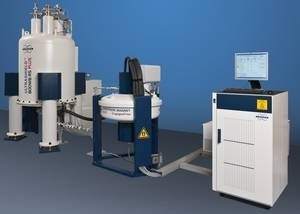
527 GHz DNP-NMR. Image Credit: Bruker BioSpin Group
Applications
Sample Preparation and DNP-Enhanced CPMAS of 13C-Proline
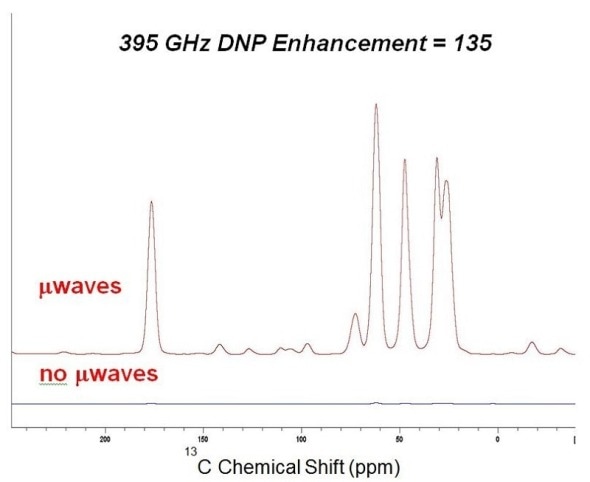
Image Credit: Bruker BioSpin Group
The DNP samples are prepared by adding a polarizing agent (such as e.g. TOTAPOL biradical) to a shared solvent or alternatively by utilizing a native radical on the sample of interest. The samples are measured under MAS while at low temperatures, typically 100–120 K. Unmodified NMR experiments are performed while benefitting from continuously DNP-enhanced signal intensity through CW microwave irradiation.
DNP-Enhanced CPMAS of 13C-Proline in Glycerol/Water with 10 mM AMUPOL at 395 GHz/600 MHz: 25 µl sample, 1.5 mg U-13C-15N Proline, 8 kHz MAS, CPMAS with Spinal 64 decoupling, 100 k sample temperature, 8 scans and 10 s recycle delay for both microwaves on and off spectra.
Improved sensitivity from DNP allows the characterization of expansin protein binding to plant cell walls
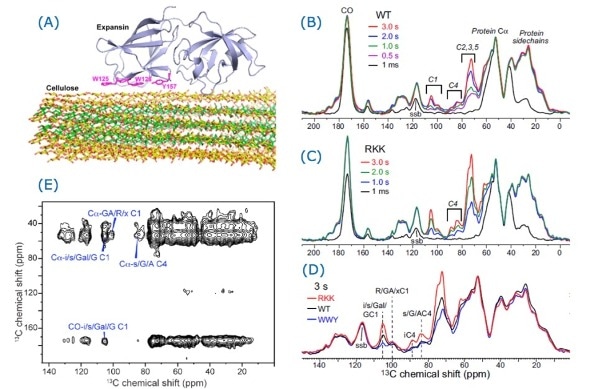
Image Credit: Bruker BioSpin Group
DNP experiments allow rapid detection of ~1% U-13C,15N expansin mixed with plant cell walls. A REDOR filter selects only signals from the expansin 13C signals and spin diffusion mixing following the REDOR filter reveals correlations between expansin and the cell-wall polysaccharides. Comparison of the wild-type protein with two mutants indicate that site-specific cellulose binding is correlated with strong wall-loosening activity.
Fig. 3. (A) Graphic depicting expansin binding to plant cell walls. WT (B) and RKK mutant (C) spin diffusion spectra showing the buildup of signals from the protein to the cell-wall polysaccharides. (D) Comparison of signals transferred from the WT and two mutants to the plant cell walls. (E) 2D 13C-13C spectrum showing direct evidence of protein-polysaccharide correlations through spin diffusion.
T. Wang et al. PNAS 2013, 110, 16444-16449
DNP-enhanced NMR in biological solids
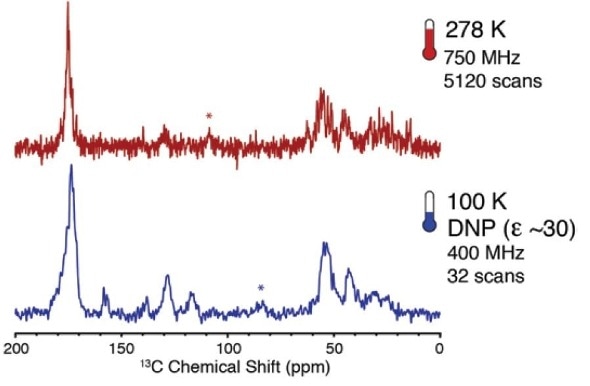
Image Credit: Bruker BioSpin Group
A wide range of biological samples have been successfully enhanced on the Bruker DNP-NMR spectrometer including small peptides, soluble proteins, membrane proteins, and large biological complexes.
z-filtered (ZF) TEDOR experiment comparing sensitivity and spectral content at 300 K, 700 MHz without DNP and 100 K, 400 MHz with DNP;
M. J. Bayro, et al. J. Am. Chem. Soc., 2011, 133, 13967.
Material Science
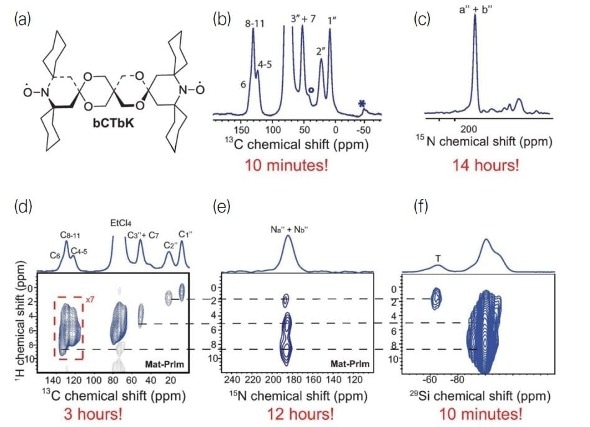
Image Credit: Bruker BioSpin Group
DNP NMR allows the characterization, at the molecular level, of hybrid organic silica material. These materials are key compounds for applications in catalysis, drug delivery, separation and purification devices.
DNP experiments on natural abundance Mat-PrIm: (a) Structure of bCTbK polarizing agent; DNP-enhanced 13C, (b) and 15N (c) 1D spectra and 1H- 13C (d), 1H- 15N (e), 1H-29Si, (f) heteronuclear correlation spectra. 1H DNP signal enhancement = 78 at 100,
K. A. Zagdoun et al. J. Am. Chem. Soc., 2012, 134, 2284.
Software Pharmaceutical Analysis: Fragment-based Screening by NMR
Video Credit: Bruker BioSpin Group